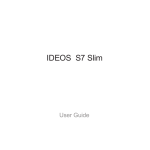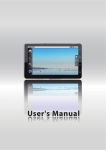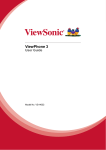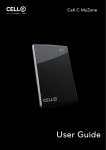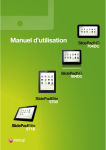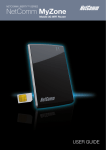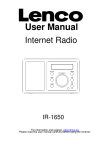Download Lenovo S2109A-F User's Manual
Transcript
IdeaTab S2109A-F User Guide Table of Contents Chapter 1: Getting Started.................................................................... 1 1.1 Your Device.................................................................................................. Front ........................................................................................................................ Back ......................................................................................................................... Top........................................................................................................................... Side .......................................................................................................................... 1.2 Installing Memory Card............................................................................... 1.3 Charging the Battery................................................................................... 1.4 Turning the Device On or Off ..................................................................... 1.5 Unlocking the Screen.................................................................................. 1 1 1 2 2 2 3 3 4 Chapter 2: The Basics........................................................................... 5 2.1 Home Screen ............................................................................................... 5 Extended Home screen ............................................................................................ 5 Status Bar Icons....................................................................................................... 6 Shortcut menu.......................................................................................................... 7 Using widgets .......................................................................................................... 8 Applications............................................................................................................. 9 Setting wallpaper ..................................................................................................... 9 2.2 Adjusting Volume...................................................................................... 11 2.3 Setting up Wi-Fi ......................................................................................... 12 2.4 People......................................................................................................... 15 Adding contacts ..................................................................................................... 15 Importing contacts ................................................................................................. 16 Backing up contacts............................................................................................... 16 Favorite contacts.................................................................................................... 17 Chapter 3: Email .................................................................................. 18 3.1 Email Accounts ......................................................................................... 18 Setting up an Internet email account ..................................................................... 18 Viewing email accounts ........................................................................................ 19 Chapter 4: Using Internet ................................................................... 20 4.1 Browsing Web Pages................................................................................ 20 Managing web pages ............................................................................................. 21 Chapter 5: Using Bluetooth................................................................ 22 5.1 Connecting to Bluetooth Devices............................................................ 22 Chapter 6: Multimedia Applications .................................................. 23 6.1 Photos and Videos .................................................................................... Taking a photo....................................................................................................... Recording a video.................................................................................................. Reviewing a photo................................................................................................. Reviewing a video ................................................................................................. Configuring camera settings.................................................................................. i 23 23 24 24 25 25 Table of Contents 6.2 Viewing Photos & Videos ......................................................................... Viewing photos...................................................................................................... Playing videos ....................................................................................................... 6.3 Using Music Player ................................................................................... Music screen .......................................................................................................... 27 27 28 29 29 Chapter 7: Applications ...................................................................... 30 7.1 Books ......................................................................................................... 7.2 Browser ...................................................................................................... 7.3 Calculator................................................................................................... 7.4 Calendar ..................................................................................................... 7.5 Clock........................................................................................................... 7.6 Downloads ................................................................................................. Managing files ....................................................................................................... 7.7 File Browser............................................................................................... Managing files and folders .................................................................................... 7.8 FM Radio .................................................................................................... 7.9 Gallery ........................................................................................................ 7.10 Places ....................................................................................................... 7.11 Search ...................................................................................................... Searching information by entering text ................................................................. 7.12 Settings .................................................................................................... 7.13 Voice Note................................................................................................ 30 31 31 32 32 33 33 34 34 35 36 36 37 37 37 38 Chapter 8: Managing Your Device ..................................................... 39 8.1 Device Settings.......................................................................................... WIRELESS & NETWORKS ................................................................................ DEVICE ................................................................................................................ PERSONAL .......................................................................................................... SYSTEM ............................................................................................................... 8.2 Changing Basic Settings .......................................................................... Date and time settings ........................................................................................... Alarms settings ...................................................................................................... Display settings ..................................................................................................... Ringtone settings ................................................................................................... 8.3 Using Wireless & networks ...................................................................... 8.4 Protecting Your Device............................................................................. Screen lock protection settings .............................................................................. 8.5 Resetting the Device ................................................................................. 39 39 39 40 41 44 44 45 45 46 47 47 47 47 Safety Information .................................................................................................. 48 ii Chapter 1: Getting Started Chapter 1: Getting Started 1.1 Your Device Front Power button Touch screen Camera Light sensor Back Speakers 1 Speakers Chapter 1: Getting Started Top Volume +/- button Side Headset jack DC jack Micro USB port MicroSD slot Microphone Micro HDMI port 1.2 Installing Memory Card You need a microSD® card to store photos, music, videos, and other data. To install the memory card 1. Open the card cover. 2. Insert the microSD card as shown. Make sure the gold contacts are facing down. To remove the memory card 1. Open the card cover. 2. Push to eject the microSD card from the slot. NOTE: Do not remove the memory card while the device is turned on. Sudden removal of the memory card may cause data loss or unpredictable system hang up. 2 Chapter 1: Getting Started 1.3 Charging the Battery The battery is only partially charged. To fully charge the battery, charge it for 5 hours. Charge the battery 1. Connect one end of the AC adapter to the DC jack of the device. 2. Plug the other end of the AC adapter to the wall outlet to start charging. When the battery is charging and the device is turned on, the icon is displayed on the status bar. When the battery is fully charged and the AC adapter is removed from the device, the icon is displayed on the status bar. NOTE: • Battery can also be charged when the device is connected to a computer using the micro USB cable. • Users have to use the connection to USB interfaces with USB 2.0 version or higher. 1.4 Turning the Device On or Off After installing the memory card and charging the battery, the device is ready to be turned on. To turn on your device Press and hold the Power button until the device vibrates. To turn off your device 1. Press and hold the Power button for 1 second. 3 Chapter 1: Getting Started 2. A pop-up window will then appear, tap OK to confirm. To put your device in Sleep mode To put your device in Sleep mode, press the Power button. This will turn the display off. To turn the display on, press the Power button again. 1.5 Unlocking the Screen By default, the screen automatically locks after a period of inactivity. You can set the length of time until the screen locks, see “To turn off backlight when the device is idle” on page 45. To unlock the screen 1. Press the Power button to turn on the display from Sleep mode. 2. Drag the middle circle ( ) to to unlock the screen. NOTE: To use the camera function directly, drag the middle circle ( ) to . 4 Chapter 2: The Basics Chapter 2: The Basics 2.1 Home Screen From the Home screen, you can quickly access common features and view notifications of received messages, battery and connection status. Launcher icon Tap to view the applications and settings of the device. Swipe left/ right to view the extended Home screen. Home Tap to return to Home. Return Tap to return to the previous screen. Recent Apps Tap to view the recent applications. Status bar Displays status and notification icons. Extended Home screen Swipe your finger to the left or right across the Home screen. The two extensions to the left and to the right of the Home screen provide more space for icons, widgets, shortcuts, and other items. 5 Chapter 2: The Basics Status Bar Icons Status bar icons indicate different types of information. The icons on the status bar indicate the following information: Battery icon Memory card icon Operation icons (Return/Home/History) Current time See “Home Screen” on page 5. Icon Description Network icon Icon Description Battery full Wi-Fi is connected Battery low Bluetooth connection active Battery charging File download in progress New Email notification Headset connected Device is connected to PC via USB connection FM radio on Tap the status bar and scroll up to view notifications or view system information easily. To close the window, tap . 6 Chapter 2: The Basics Shortcut menu The shortcut menu allows you to easily access an application from the Home screen. To open an application, tap an icon. Customizing shortcut menu To add a shortcut: 1. Tap . 2. Tap APPS to display the applications. 3. To add an item, drag the application icon to the specific Home screen. To remove shortcut: 1. Tap and hold an application icon. 2. Drag the application icon to from the Home screen. 7 to delete. The application icon is removed Chapter 2: The Basics Using widgets Save time with live updates right on the Home screen and get all your personalized updates in one place. You may add and customize the Widgets on the Home screen as you like. 1. From the Home screen, tap . 2. Tap WIDGETS to display applications. All available widgets are displayed. 3. To add a widget, drag the widget icon to the specific Home screen. To remove widgets: 1. From the Home screen, tap and hold the desired widget. 2. Drag the widget to to delete it from the Home screen. 8 Chapter 2: The Basics Applications Tap to view applications and device settings. Tap an icon to access the application. Setting wallpaper You can customize the wallpaper of your Home screen with a default wallpaper or with pictures taken with your device. Set wallpaper from My Gallery 1. From the Home screen, tap and hold the screen. 2. Tap Gallery. 3. Browse the files. Tap to select the picture you want to use as wallpaper. 9 Chapter 2: The Basics 4. Drag your finger to select the crop area. 5. Tap CROP to set the cropped photo as wallpaper. Set wallpaper from Live Wallpaper gallery 1. From the Home screen, tap and hold the screen. 2. Tap Live Wallpapers. 3. Tap to browse the desired live wallpaper. 4. Tap Set wallpaper to set the desired live wallpaper to set as Home screen wallpaper. Set wallpaper from Wallpaper gallery 1. From the Home screen, tap and hold the screen. 2. Tap Wallpapers. 3. Browse the available wallpapers. 10 Chapter 2: The Basics 4. Tap Set wallpaper to set the desired wallpaper as the Home screen wallpaper. 2.2 Adjusting Volume This device features three types of volume which can be adjusted separately: • • • Media volume: Set the volume for music, videos, games and other media. Notification volume: Set the volume for notifications. Alarm volume: Set the volume for alarms. To adjust the volume 1. From the Home screen, tap > Settings. 2. In DEVICE, tap Sound > Volumes. 3. To adjust the volume, drag the respective volume slider to adjust the volume. 4. Tap OK to save your settings. 11 Chapter 2: The Basics 2.3 Setting up Wi-Fi This device only supports Wi-Fi connections to access the Internet. You need to connect to a wireless network before surfing the Internet or using the related applications that require Internet connection. To turn Wi-Fi on 1. From the Home screen, tap > Settings. 2. In WIRELESS & NETWORKS, tap Wi-Fi and set it to ON. To connect to a Wi-Fi network 1. Turn Wi-Fi on. 2. The available networks are listed. Tap a network to connect to. NOTE: You can also tap ADD NETWORK to manually add a connection. See “To add a Wi-Fi network” on page 13. 3. If you select an unsecured network, the connection is automatically established. Otherwise, proceed to the next step. 12 Chapter 2: The Basics 4. When connecting to a secured network, you will be prompted for the password. Enter the password, then tap Connect. When Wi-Fi is connected, the connection icon is displayed on the status bar. To add a Wi-Fi network 1. From the Home screen, tap > Settings. 2. In Wi-Fi networks, tap ADD NETWORK. A new window is displayed. 3. Follow the on-screen instructions and enter the necessary information, then tap Save to save the settings. 13 Chapter 2: The Basics To view Wi-Fi settings 1. From the Home screen, tap 2. In Wi-Fi networks, tap > Settings. > Advanced. Network information appears on the screen. 14 Chapter 2: The Basics 2.4 People People lets you store names, phone numbers, email addresses, and other information. You can also add frequently used contacts to the Favorites list. See “Favorite contacts” on page 17. Adding contacts 1. From the Home screen, tap 2. Tap > People. to add a contact. NOTE: If the contact list is empty, tap one of the following: • Create a new contact: to save the contact to the device memory. • Sign in to an account: to retrieve the contacts stored on a corporate or other account. • Import/export contacts: to import/export contacts from/to the storage. 3. Enter contact information such as name, phone number, email address, etc. 4. When finished, tap changes. 15 to save the contact or tap to exit without saving any Chapter 2: The Basics Importing contacts You can import contacts from the memory card to your device. 1. From the Home screen, tap > People. 2. Tap > Import/export. 3. Select Import from storage. 4. Select the vCard files to import and tap OK. Backing up contacts You can copy contacts to the memory card to back up your contacts information. 1. From the Home screen, tap > People. 2. Tap > Import/export > Export to storage. 3. A warning message pops up, tap OK to proceed. All contacts are copied to the memory card. 16 Chapter 2: The Basics Favorite contacts Add the most frequently called contacts to the FAVORITES list to help you access contacts quickly and easily. Add to Favorites List 1. From the Home screen, tap > People. 2. Tap ALL tab and select a contact. 3. Tap and the icon turns blue. The contact is now displayed in the FAVORITES list. Remove from Favorites List 1. From the Home screen, tap > People. 2. Tap ALL tab and select a contact. 3. Tap a contact and tap . The contact is removed from the FAVORITES list. 17 Chapter 3: Email Chapter 3: Email Use Email to send and receive email messages via your internet email accounts. 3.1 Email Accounts Your device can send and receive emails just as you do with a computer. Your device supports email accounts provided by an Internet Service Provider (ISP) or web-based email, such as Hotmail, Yahoo! Mail, etc. Setting up an Internet email account 1. From the Home screen, tap > Email. 2. Enter your Email address and Password. 3. Tap Next. The device will automatically retrieve the email settings. 4. Set your account options and tap Next. 5. Enter Your Name and Account display name. NOTE: The Account display name is the name shown to the recipients of your emails. 6. Tap Next. Once the account set up is completed, the device will automatically retrieve your emails. • To add another email account, tap > Settings > ADD ACCOUNT. 18 Chapter 3: Email Viewing email accounts 1. From the Home screen, tap > Email. 2. Tap the account selection box at the top left of the screen. 3. Tap the account you want to access from the available email accounts. Customizing email settings Configure message settings using the Account settings menu. 1. From the Home screen, tap > Email. 2. Tap the account you want to access. 3. Tap 19 > Settings to open the email setting menu. Chapter 4: Using Internet Chapter 4: Using Internet 4.1 Browsing Web Pages 1. 2. 3. 4. From the Home screen, tap > Browser. Tap the address bar. Type the URL. As you type, a list of URL suggestions will appear on the screen. Tap an item in the list. Address bar Tap to browse bookmarks, history, and saved pages. To navigate a page To scroll up or down, swipe your finger down or up. To scroll left or right, tap and swipe your finger to the right or left. To bookmark the page 1. Tap . 2. Enter the label and change other default settings (if necessary). 3. Tap OK to save your settings. To set the Home page 1. While viewing a web page, tap > Settings > Set homepage. 2. Select the page that you want to set as the home page. • Tap OK to save your settings. • If “Other” is selected, enter the URL of the page that you want to set as the home page. 20 Chapter 4: Using Internet Managing web pages While viewing a web page, tap • • • • • • 21 to configure the browser settings: General: Select to set home page, and configure sync data and autofill settings. Privacy & security: Select to configure privacy and security settings including cache, history, cookies, form data, location, and password. Accessibility: Select to configure text size, zoom, and inverted screen rendering settings. Advanced: Select to set search engine, open in background, enable JavaScript, enable plug-ins, advanced settings for individual website, page content settings, and reset all settings to the factory default. Bandwidth management: Select to allow browser to preload high confidence search results in the background and display images on the web pages. Labs: Select to set quick control access. Chapter 5: Using Bluetooth Chapter 5: Using Bluetooth To turn Bluetooth on 1. From the Home screen, tap > Settings. 2. In WIRELESS & NETWORKS, tap Bluetooth and set it to ON. NOTE: When the Bluetooth is turned on, your device detects other Bluetooth devices, but your device is not visible to others. 3. To make your device visible to others, tap IdeaTabS2109A-F once to make this device visible to other devices. 5.1 Connecting to Bluetooth Devices A connection to a Bluetooth device is called a partnership. You need to pair and create a partnership with a Bluetooth device to exchange information. 1. 2. 3. 4. 5. From the Home screen, tap > Settings. In WIRELESS & NETWORKS, tap Bluetooth and set it to ON. To search for a new device, tap SEARCH FOR DEVICES. Tap a detected device. To start pairing, enter the PIN and tap OK. NOTE: • The PIN of the device must be the same PIN on the other bluetooth device. • On some devices, tap Pair to start pairing. 6. The paired bluetooth device name is displayed. NOTE: Once a partnership has been created, connecting to that device again will no longer require entering the PIN. 22 Chapter 6: Multimedia Applications Chapter 6: Multimedia Applications 6.1 Photos and Videos This device is equipped with a front camera to take photos and videos. Taking a photo Tap to preview the latest captured photo. Tap to take a photo. 1. From the Home screen, tap > Camera. 2. Aim the device at the subject. Slide 3. Tap to or to zoom in/out on the subject. to take the shot. The latest photo will be displayed on the top right of the screen. Tap the thumbnail to view it in full screen. 23 Chapter 6: Multimedia Applications Recording a video Tap to preview the latest recorded video. Tap to record video. 1. From the Home screen, tap > Camera. 2. Tap to switch to Camcorder mode. 3. Aim the device at the subject. 4. To start recording, tap . To stop recording, tap . Reviewing a photo After taking a photo, tap the window located at top right corner to preview the latest captured photo on the screen. • • • To share the photo, tap an application for sharing. To view other photos in Gallery, tap . To return to Camera mode, tap . 24 Chapter 6: Multimedia Applications Reviewing a video After recording a video, tap the window located at top right corner to preview the latest recorded video on the screen. • • • • Tap to play the video. To share the video, tap an application for sharing. To view other videos in Gallery, tap . To return to Camcorder mode, tap . Configuring camera settings Tap to access the camera/camcorder menu. Tap the menu item icon to open the respective menu and select the desired setting. Tap an option to configure camera settings. 25 Chapter 6: Multimedia Applications Tap to view and adjust the general settings of your camera: Mode Setting Available options Auto, Incandescent, Daylight, Fluorescent, Cloudy (White balance) Camera mode -3, -2, -1, 0, +1, +2, +3 (Exposure) Store location (On, Off), Picture quality (Super fine, Fine, Normal), Shutter sound (On, Off), Picture size (1.3M pixels, VGA, QVGA), Restore defaults (OK, Cancel) (Camera settings) Auto, Incandescent, Daylight, Fluorescent, Cloudy (White balance) Camcorder mode (Effect) SILLY FACES (Squeeze, Big eyes, Big mouth, Small mouth, Big nose, Small eyes) (Time lapse interval) Off, 1s, 1.5s, 2s, 2.5s, 3s, 5s, 10s HD (720p), SD (480p) (Video quality) Video duration (30 minutes, 10 minutes, 30 seconds), Store location (On, Off), Restore defaults (OK, Cancel) (Camera settings) NOTE: To exit the menu mode, tap . 26 Chapter 6: Multimedia Applications 6.2 Viewing Photos & Videos Viewing photos 1. From the Home screen, tap > Gallery. 2. Tap the desired folder to view the images in thumbnails. 3. Tap an image to view. 4. Swipe your finger to the left/right to view the previous/next image. • To share the photo, tap , then tap an application for sharing. • To delete the photo, tap . Then, tap Delete to confirm file deletion. • To edit the photo, tap 27 to show more options. Chapter 6: Multimedia Applications Playing videos 1. From the Home screen, tap > Gallery. 2. Tap the desired folder to view the videos in thumbnails. 3. Tap the video to playback. 28 Chapter 6: Multimedia Applications 6.3 Using Music Player You can transfer music to the device from the computer. From the Home screen, tap > Music. Music screen • Playback screen: Displays the playback area with the playback controls. Album art picture or animation. Audio information display area. Go to next song. Drag the slider left/right to go forward or backward. 29 Go to previous song. Play or pause the song. Chapter 7: Applications Chapter 7: Applications Your device comes with the following pre-installed applications. 7.1 Books With Books, you can download or purchase ebooks from an online store, and view them on your device. Browsing an EBook 1. From the Home screen, tap > Books. 2. Select an ebook from your bookshelf and tap to open the book. 3. Swipe your fingers right and left to flip to the previous and the next page. Customizing the Viewing Settings On any page, touch the screen. Select one of the following options that you want to adjust: • : Tap to search for desired content in the book. • : Tap to jump to the desired chapter. • : Tap to toggle night or daylight reading mode, configure the font type and size, brightness level, text alignment, and line height. • : Tap to view the book information, share the book information with others, make it available offline, and read the content aloud. 30 Chapter 7: Applications 7.2 Browser Open Browser to view web pages. See “Browsing Web Pages” on page 20. 7.3 Calculator With Calculator, you can perform basic arithmetic functions on your device. 1. From the Home screen, tap > Calculator. 2. Use the on-screen calculator keypad to perform arithmetic calculation. 31 Chapter 7: Applications 7.4 Calendar The Calendar lets you schedule and sound alarms for appointments, meetings and other events. Scheduled appointments for the day can be displayed on the Home screen. To schedule an event 1. From the Home screen, tap 2. Tap > Calendar. . 3. Enter the event details. 4. Select the date and time for From and To fields. NOTE: For an all-day event, check All day. 5. To set repetition, select the repetition from the list. 6. To set a reminder, select the time from the list. 7. When finished, tap . TIP: From the Calendar screen, tap and hold a day or a time slot then set a new appointment on the selected date or time. 7.5 Clock Set alarms with this device. See “Alarms settings” on page 45. 32 Chapter 7: Applications 7.6 Downloads Use Downloads to view or delete what you have downloaded in Browser. NOTE: The downloaded files are stored in the “Download” folder in your memory card. 1. From the Home screen, tap 2. Tap an item to view. > Downloads. Managing files • • • • • 33 To delete a file, tap the check box on the left side of the image. A blue tick appears, tap . To share a file, tap the check box on the left side of the image. A blue tick appears, tap . To sort the file by size, tap Sort by size. To sort the file by time, tap Sort by date. To view files that have been downloaded earlier, tap the headings. Chapter 7: Applications 7.7 File Browser File Browser lets you browse the contents of your device and the memory card. 1. From the Home screen, tap > File Browser. 2. Tap the folder list and tap the folder you want to explore. Managing files and folders • To open a folder or file, tap the file or folder. • To move, delete, rename or view file or folder details, tap and hold to view the options. Then tap a desired option. • To copy, tap and hold a file or folder, then tap Copy. To paste a file or folder, tap > Paste. • To create a new folder, tap • To sort items, tap • To mark a file or folder, tap • To copy all files and folders, tap • To delete all files and folders, tap • To search for a file, tap > New folder. > Sort, then tap a sorting option. > Mark. > Copy all. > Delete all. > Search. 34 Chapter 7: Applications 7.8 FM Radio FM Radio lets you listen to the FM radio. NOTE: You must connect a headset or earphones to use this function. 1. From the Home screen, tap > FM Radio. 2. Do any of the following: • • • • • • • • • 35 To manually tune to a frequency, tap on a desired frequency. To tune to another radio station, tap or . To view the Favorite List, tap . To add the current radio station into the Favorite list, tap , and then enter the station name and tap OK. To set the desired radio station frequency, tap . Enter the radio frequency and tap OK. To turn on the speaker, tap > Speaker on. To mute the sound, tap > Mute. To change other radio settings, tap > Settings. To turn off the radio, tap . Chapter 7: Applications 7.9 Gallery You can view your captured images, recorded video clips, and downloaded images in Gallery. 1. From the Home screen, tap > Gallery. 2. Tap the desired folder to view the camera pictures or camera videos. 3. The images or videos are displayed in thumbnails. 4. To view photos or videos, see “Viewing Photos & Videos” on page 27. 7.10 Places Places is a location-based application that helps you find the places and things around you. Local information available includes restaurants, cafes, bars, attractions, entertainment, gas stations, post office, ATMs, hotels, taxi, and more. This application also helps you get where you are going with maps and directions. From the Home screen, tap > Places. 36 Chapter 7: Applications 7.11 Search From the Home Screen, you can search information on your device and on the web with Search right away. Searching information by entering text 1. From the Home screen, tap > Search. 2. Enter the text you are searching in the search box. 3. As you type, matching items on your device and suggestions from web search are added to the list of previously chosen search results. Tap a match item in the list. 4. If what you are searching is not in the list, tap displaying results of a search on the web. . The Browser opens, 7.12 Settings In the Settings menu, you can view and make adjustments for wireless & network settings and the general and security settings of your device. See “Device Settings” on page 39. 37 Chapter 7: Applications 7.13 Voice Note Use Voice Note to record a voice memo. To record a voice note 1. From the Home screen, tap > Voice Note. 2. The recording screen is displayed. 3. Tap to record your voice. 4. To stop recording, tap . To play a voice note 1. Tap . 2. A list of voice notes is displayed. 3. Tap the voice note you want to listen to. 38 Chapter 8: Managing Your Device Chapter 8: Managing Your Device 8.1 Device Settings From the Home screen, tap > Settings to view and adjust the settings of your device. Settings menu is categorized into: WIRELESS & NETWORKS, DEVICE, PERSONAL, and SYSTEM. WIRELESS & NETWORKS Application Description Wi-Fi Manage Wi-Fi connections, scan and connect to available Wi-Fi networks. Bluetooth settings Manage Bluetooth connections, set device name, and discoverability of the device. Data usage View data usage used by the applications. Airplane mode Disable all wireless connections. VPN Set up and manage Virtual Private Networks (VPNs). Tethering Share your tablet’s data connection via USB or Bluetooth. DEVICE Item Description SRS Enable SRS TruMedia sound system. Sound 39 Volumes Adjust the volume for media, notification, and alarms. Default notification Set your default notification ringtone. Vibrate Device vibrates for new notifications. Touch sounds Enable/disable sound when selecting items on the screen. Screen lock sound Play sounds when locking or unlocking the screen. Vibrate on touch Enable/disable vibration when selecting items on the screen. Chapter 8: Managing Your Device Item Display Storage Description Brightness Adjust the brightness of the screen. Wallpaper Customize the device wallpaper. Auto-rotate screen Switch orientation automatically when rotating the device. Sleep Adjust delay before the screen automatically goes off. Font size Set the font size. INTERNAL STORAGE Show total space, currently used by applications, and remaining device storage. SD CARD Show total and available memory card storage and unmount the SD card to safely remove the card. USB STORAGE Mount USB storage. Battery View the battery usage on currently running applications and battery charging status. Apps View and control downloaded and currently running services. PERSONAL Application Location services Security Security Description Location service Allow location to be determined by Wi-Fi. GPS satellites Enable GPS satellites. Location & search Use your location to improve search results and other services. Screen lock Set the lock screen by sliding the screen or with a pattern, PIN, or password. Owner info Show owner information on the lock screen. Encrypt tablet Require a numeric PIN or password to decrypt your tablet each time you power on the device. Make passwords visible Show passwords as you type. Device administrators View or deactivate device administrators. Unknown sources Allow installation of non-Market applications. Trusted credentials Display trusted CA certificates. Install from SD card Install encrypted certificates from SD card. Clear credentials Clear credential storage of all contents and reset its password. 40 Chapter 8: Managing Your Device Application Language & input Description Language Set the on-screen display language for your device. Spelling correction Enable/disable spell check function. Personal dictionary Add or edit user preset words to the dictionary. Default Set the default keyboard input method. Voice typing Configure Voice typing settings. TouchPal Keyboard(Pad) Configure on-screen keyboard settings. Voice Search Configure Voice Search settings. Text-to-speech output Set the text-to-speech settings. Pointer speed Configure pointer speed. Back up my data Back up the current settings and other application data. Backup account Back up the account data for debugging purpose. Automatic restore Automatically restore backed up settings and other data after reinstalling an application. Factory data reset Delete all data on the device and restore to factory default settings. Backup & reset SYSTEM Application Date & time 41 Description Automatic date & time Check to use network provided time. Set date Set the date. Set time Set the time. Select time zone Select the time zone of your current location. Use 24-hour format Set the clock to 24-hour format. Select date format Set the preferred date format. Chapter 8: Managing Your Device Application Accessibility Developer options Description TalkBack Enable/disable TalkBack function and customize its settings. Large text Change to a larger font size. Auto-rotate screen Switch orientation automatically when rotating the device. Speak passwords Read aloud passwords as you type. Touch & hold delay Set the delay until a touch is interpreted as a touch & hold. Install web scripts Allow applications to install scripts that make their web content more accessible. USB debugging Enable/disable debug mode when a USB is connected. Development device ID View development device ID. Stay awake Set the screen to never sleep while charging. Allow mock locations Allow mock location. Desktop backup password Set desktop backup password. Strict mode enabled Screen flashes when applications do long operations on main thread. Pointer location Screen overlays to show the current touch data. Show touches Show visual feedback for touches. Show screen updates The updated screen flashes when it is being updated. Show CPU usage Screen overlays to show the current CPU usage. Force GPU rendering Use 2D hardware acceleration in applications. Window animation scale Set the window animation scale ratio. Transition animation scale Set the transition animation scale ratio. Don’t keep activities Destroy every activity as soon as the user leaves it idle. Background process limit Set the background process limit. 42 Chapter 8: Managing Your Device Application Description Developer options Show all ANRs Show all applications which are not responding to background applications. System update Configure the system update settings and view the last check status. Status View the status of battery, network, and other information. User Guide View the device user’s manual. Legal information View Open source licenses and legal information. Model number View the device model number. Android version View Android version. Kernel number View Kernel version. Build number View Build number About tablet 43 Chapter 8: Managing Your Device 8.2 Changing Basic Settings Date and time settings To automatically set the date and time 1. From the Home screen, tap > Settings. 2. In SYSTEM, tap Date & time. 3. Tap Automatic date & time to automatically set the date and time according to the network. To manually set the date and time 1. From the Home screen, tap > Settings. 2. In SYSTEM, tap Date & time. 3. Tap Set date to set the date. • To adjust the date, tap the month, day, or year field, and tap S or T to increase or decrease the value. Tap Set to apply the values. • To change the date format, tap Select date format, and select the date format from the list. 4. Tap Select time zone to select the time zone from the list. 5. Tap Set time to set the time. • To adjust the time, tap the hour, minute, second or AM/PM field, and tap + or to increase or decrease the value. Tap Set to apply the values. • To use a 24-hour format, tap Use 24-hour format. 44 Chapter 8: Managing Your Device Alarms settings You can set up alarms on this device. To set the alarm 1. From the Home screen, tap > Clock. 2. Tap . 3. To add an alarm, tap Add alarm. 4. Tap the S or T to set the alarm time, and tap Set. 5. 6. 7. 8. 9. To set repeat mode, tap Repeat. Tap one or more options, then tap OK. To set the ringtone, tap Ringtone. Tap an option, then tap OK. To vibrate when alarm sounds, check Vibrate. To add an alarm label, tap Label. After all settings are complete, tap OK. Display settings The display settings of this device affect the battery and external power level. To turn off backlight when the device is idle 1. 2. 3. 4. 45 From the Home screen, tap > Settings. In DEVICE, tap Display. Tap Sleep. Select the desired length of time. Your setting is automatically saved. Chapter 8: Managing Your Device To adjust brightness 1. 2. 3. 4. 5. From the Home screen, tap > Settings. In DEVICE, tap Display. Tap Brightness. Drag the Brightness slider to adjust brightness settings. Tap OK when finished. To change the screen orientation 1. From the Home screen, tap > Settings. 2. In DEVICE, tap Display. 3. Tap Auto-rotate screen to automatically switch the screen orientation when rotating the device. Ringtone settings You can assign a default ringtone whenever a new notification is received. To change the notification ringtone 1. 2. 3. 4. 5. From the Home screen, tap > Settings. In DEVICE, tap Sound. Tap Default notification. Tap the preferred ringtone from the list. Tap OK to confirm. 46 Chapter 8: Managing Your Device 8.3 Using Wireless & networks Wireless & networks allows you to manage Wi-Fi, Bluetooth, Tethering, and Virtual Private Networks (VPNs). 1. From the Home screen, tap > Settings. 2. In WIRELESS & NETWORKS, do any of the following (if necessary): • To enable/disable or configure Wi-Fi settings, tap Wi-Fi. • To enable/disable or configure Bluetooth settings, tap Bluetooth. • To enable/disable Airplane mode, tap More > Airplane mode. • To set up and manage Virtual Private Networks (VPNs), tap More > VPN. • To share your device mobile data connection via USB or Bluetooth, tap More > Tethering. 8.4 Protecting Your Device You can protect your device from unauthorized users by requiring the PIN code or entering a password. Screen lock protection settings You can increase your device's security by creating a screen unlock pattern (disabled by default). When enabled, you must trace the correct unlock pattern on the screen to unlock and regain access to the device. 1. 2. 3. 4. 5. From the Home screen, tap > Settings. In PERSONAL, tap Security. Tap Screen lock. Tap Pattern to trace the pattern to unlock the screen. Follow the on-screen instructions to trace your own personal unlock pattern and tap Continue. 6. Retrace your unlock pattern again and tap Confirm. 8.5 Resetting the Device You can reset your device to its factory defaults. 1. 2. 3. 4. 47 From the Home screen, tap > Settings. In PERSONAL, tap Backup & reset. Tap Factory data reset. Tap Reset tablet to reset. Safety Information Safety Information Please read before proceeding • • • • • • • • • Following all precautions and instructions will increase the life of device. Use only the battery and the power adapter provided by the manufacturer. Use of unauthorized accessories may void your warranty. Avoid using the device near electromagnetic sources such as TVs, radios, and microwave ovens. Unplug the power adapter from the wall outlet during lightning storms to avoid electric shock or fire. Do not expose the device or the battery to direct sunlight. Do not store your device in temperatures higher than 55ºC. Do not use harsh chemicals or detergents to clean your device. Do not handle the device with wet hands while it is being charged. This may cause an electric shock or serious damage to the device. The operating temperature for this device is from -10ºC to 55ºC. SAFETY PRECAUTIONS FOR BATTERY USE • The battery is not removable. • End users shall not remove the embedded battery by themselves. • Use only approved battery. • Keep the battery dry and away from any liquid since this may cause a short circuit. • Keep the battery away from metal objects since this may cause a short circuit. • Do not use damaged or deformed batteries. • If the battery emits a foul odor, discontinue use. • Keep the battery away from babies and small children. If the battery leaks: • Do not allow the leaking fluid to come in contact with your skin, eyes or clothing. If already in contact, rinse with clean water immediately and seek medical advice. • Keep the battery away from fire since this may cause the battery to explode. • Do not attempt to open or service the battery yourself. • Do not dispose battery in fire or water. • Recycle or dispose used batteries according to the local regulations. ROAD AND ENVIRONMENTAL SAFETY • Turn off the device in areas with a potentially explosive atmosphere or where flammable objects exist such as gas stations, fuel depots, and chemical plants among others. Sparks from these areas could cause explosion or fire and result in injury or even death. • Do not use device while driving a vehicle. 48 Safety Information SAFETY IN AIRCRAFT Do not use the device on board an aircraft. The device’s network signals may cause interference to the navigation system. As a safety measurement, it is against the law in most countries to use the device on board an aircraft. Copyright© 2012. All Rights Reserved. Android is a trademark of Google Inc. Use of this trademark is subject to Google Permissions. This product has an Android™ platform based on Linux, which can be expanded by a variety of JME-based application SW. All products use in this device and trademarkes mentioned herein are trademarks or registered trademarks of their respective owners. Google™, the Google logo, Android™, the Android logo and Gmail™ are trademarks of Google Inc. Use of this trademark is subject to Google Permissions. Wi-Fi and the Wi-Fi CERTIFIED logo are registered trademarkes of the Wireless Fidelity Alliance. microSD™ is a trademark of SD Card Association. Bluetooth and the Bluetooth logo are trademarks owned by Bluetooth SIG, Inc. Java, JME and all other Java-based marks are trademarks or registered trademarks of Sun Microsystems, Inc. in the United States and other countries. The prediction engine of the input method is TOUCHPAL, provided by COOTEK. SAR Information THIS MOBILE DEVICE MEETS GUIDELINES FOR EXPOSURE TO RADIO WAVES. Your mobile device is a radio transmitter and receiver. It is designed not to exceed the limits for exposure to radio waves recommended by international guidelines. These guidelines were developed by the independent scientific organization ICNIRP and include safety margins designed to assure the protection of all persons, regardless of age and health. The exposure guidelines for mobile devices employ a unit of measurement known as the Specific Absorption Rate or SAR. The SAR limit stated in the ICNIRP guidelines is 2.0 W/kg averaged over 10 grams of tissue. Tests for SAR are conducted using standard operating positions with the device transmitting at its highest certified power level in all tested frequency bands. The actual SAR level of an operating device can be below the maximum value because the device is designed to use only the power required to reach the network. That amount changes depending on a number of factors such as how close you are to a network base station. The highest SAR value under the ICNIRP guidelines for use of the device at the body is 0.403 W/kg. Use of device accessories and enhancements may result in different SAR values. SAR values may vary depending on national reporting and testing requirements and the network band. The device could be used with a separation distance of 0 cm to the human body. 49 Safety Information FCC Regulations This device complies with part 15 of the FCC Rules. Operation is subject to the following two conditions: (1) This device may not cause harmful interference,and (2) this device must accept any interference received, including interference that may cause undesired operation. This device has been tested and found to comply with the limits for a Class B digital device, pursuant to Part 15 of the FCC Rules.These limits are designed to provide reasonable protection against harmful interference in a residential installation. This equipment generates,uses and can radiated radio frequency energy and, if not installed and used in accordance with the instructions, may cause harmful interference to radio communications. However, there is no guarantee that interference will not occur in a particular installation. If this equipment does cause harmful interference to radio or television reception, which can be determined by turning the equipment off and on, the user is encouraged to try to correct the interference by one or more of the following measures: - Reorient or relocate the receiving antenna. - Increase the separation between the equipment and receiver. - Connect the equipment into an outlet on a circuit different from that to which the receiver connected. - Consult the dealer or an experienced radio/TV technician for help. Changes or modifications not expressly approved by the party responsible for compliancecould void the user‘s authority to operate the equipment. RF Exposure Information (SAR) This device is compliance with SAR for general population / uncontrolled exposure limits in ANSI/IEEE C95.1-1999 and had been tested in accordance with the measurement methods and procedures specified in OET Bulletin 65 Supplement C. This equipment complies with FCC RF radiation exposure limits set forth for uncontrolled environment. This device was tested for operations with the device contacted directly to the human body to the back side of the EUT. To maintain compliance with FCC RF exposure compliance requirements, avoid direct contact to the transmitted antenna during transmitting. The highest SAR value for the device reported to the FCC when worn on the body, as describe in this user guide is 1.09 W/kg (Body-worn measurements differ among device models, depending upon available enhancements and FCC requirements.) 50 Safety Information IC Regulations This device complies with Industry Canada license-exempt RSS standard(s). Operation is subject to the following two conditions: (1) this device may not cause interference, and (2) this device must accept any interference, including interference that may cause undesired operation of the device. Le présent appareil est conforme aux CNR d'Industrie Canada applicables aux appareils radio exempts de licence. L'exploitation est autorisée aux deux conditions suivantes: (1) l'appareil ne doit pas produire de brouillage, et (2) l'utilisateur de l'appareil doit accepter tout brouillage radioélectrique subi, même si le brouillage est susceptible d'en compromettre le fonctionnement. This Class B digital apparatus complies with Canadian ICES-003. Cet appareil numérique de la classe B est conforme à la norme NMB-003 du Canada. The County Code Selection feature is disabled for products marketed in the US/ Canada. For product available in the USA/ Canada markets, only channel 1~11 can be operated. Selection of other channels is not possible. IMPORTANT NOTE: IC Radiation Exposure Statement This EUT is compliance with SAR for general population/uncontrolled exposure limits in IC RSS-102 and had been tested in accordance with the measurement methods and procedures specified in IEEE 1528. This equipment should be installed and operated with minimum distance 0 cm between the radiator & your body. 51 Safety Information WEEE Notice The WEEE logo on the product or on its box indicates that this product must not be disposed of or dumped with your other household waste. You are liable to dispose of all your electronic or electrical waste equipment by relocating over to the specified collection point for recycling of such hazardous waste. Isolated collection and proper recovery of your electronic and electrical waste equipment at the time of disposal will allow us to help conserve natural resources. Moreover, proper recycling of the electronic and electrical waste equipment will ensure safety of human health and environment. For more information about electronic and electrical waste equipment disposal, recovery, and collection points, please contact your local city center, household waste disposal service, shop from where you purchased the equipment, or manufacturer of the equipment. RoHS Compliance This product is in compliance with Directive 2002/95/EC of the European Parliament and of the Council of 27 January 2003, on the restriction of the use of certain hazardous substances in electrical and electronic equipment (RoHS) and its amendments. European Union Regulatory Conformance The equipment complies with the RF Exposure Requirement 1999/519/EC, Council Recommendation of 12 July 1999 on the limitation of exposure of the general public to electromagnetic fields (0–300 GHz). This equipment meets the following conformance standards: EN62311, EN 62209-2, EN 62479, EN 60950-1, EN 55022, EN55024, EN 50332-1, EN 50332-2, EN 301 489-1/-3/-17, EN 300 328, EN 300 400-1/-2. For the device which tests accordance to EN60950-1:2006, it is mandatory to perform audio tests for EN50332. This device have been tested to comply with the Sound Pressure Level requirement laid down in the applicable EN 50332-1 and EN 50332-2 standards. Permanent hearing loss may occur if earphones or headphones are used at high volume for prolonged periods of time. A pleine puissance, l’écoute prolongée du baladeur peut endommager l’oreille de l’utilisateur. The conformity assessment procedure has been followed with the involvement of the following Notified Body: PHOENIX TESTLAB Identification mark: CE0700 (Notified Body) CE 0700 Changes or modifications to this product not authorized by the manufacturer could void the EMC compliance and negate your authority to operate the product. This product has demonstrated EMC compliance under conditions that included the use of compliant peripheral devices and shielded cables between system components. It is important that you use compliant peripheral devices and shielded cables between system components to reduce the possibility of causing interference to radios, televisions, and other electronic devices. 52 Safety Information We, hereby, declare that this cellular, Wi-Fi, & Bluetooth radio is in compliance with the essential requirements and other relevant provisions of Directive 1999/5/EC. Intellectual Property Right Information Right to all technologies and products that comprise this device are the property of their respective owners: This product has an Android platform based on Linux, which can be expanded by a variety of Java-Script-based application SW. Google, the Google logo, Android, the Android logo, Gmail, and YouTube are trademarks of Google Inc. Bluetooth and the Bluetooth logo are trademarks owned by Bluetooth SIG, Inc. Java, JME and all other Java-based marks are trademarks or registered trademarks of Sun Microsystems, Inc. in the United States and other countries. microSD is a trademark of SD Card Association. The prediction engine of the input method is TOUCHPAL, provided by COOTEK. This equipment may be operated in: AT BE BG CH CY CZ DE DK EE ES FI FR GB GR HU IE IT IS LI LT LU LV MT NL NO PL PT RO SE SI SK TR Products with 2.4-GHz Wireless LAN Devices France For 2.4-GHz wireless LAN operation of this product, certain restrictions apply. This equipment may use the entire-2400-MHz to 2483.5-MHz frequency band (channels 1 through 13) for indoor applications. For outdoor use, only 2400-2454 MHz frequency band (channels 1-9) may be used. For the latest requirements, see http://www.arttelecom.fr. 53
























































